
Callichthyidae is a family of catfishes, called armored catfishes due to the two rows of bony plates along the lengths of their bodies. It contains some of the most popular freshwater aquarium fish, such as many species in the genus Corydoras.

Corydoras is a genus of freshwater catfish in the family Callichthyidae and subfamily Corydoradinae. The species usually have more restricted areas of endemism than other callichthyids, but the area of distribution of the entire genus almost equals the area of distribution of the family, except for Panama where Corydoras is not present. Corydoras species are distributed in South America where they can be found from the east of the Andes to the Atlantic coast, from Trinidad to the Río de la Plata drainage in northern Argentina. Species assigned to Corydoras display a broad diversity of body shapes and coloration. Corydoras are small fish, ranging from 2.5 to 12 cm in SL., and are protected from predators by their body armor and by their sharp, typically venomous spines.

Sterba's corydoras is a member of the South American Corydoras genus of freshwater aquarium catfish and one of the most popular species of Corydoras due to its attractive markings. The fish is native to the Guaporé River region between Bolivia and Brazil.

Corydoras paleatus is a species of catfish of the family Callichthyidae. Its common names include blue leopard corydoras, mottled corydoras, and peppered catfish. It originates from the lower Paraná River basin and coastal rivers in Uruguay and Brazil.

Corydoras panda is a species of catfish belonging to the genus Corydoras, of the family Callichthyidae, and is a native member of the riverine fauna of South America. It is found in Peru and Ecuador, most notably in the Huánuco region, where it inhabits the Río Aquas, the Río Amarillae, a tributary of the Río Pachitea, and the Río Ucayali river system. The species was first collected by Randolph H. Richards in 1968, and was named Corydoras panda by Nijssen and Isbrücker in 1971. The specific name is an allusion to the appearance of the fish, which possesses large black patches surrounding the eyes, reminiscent of those found on the giant panda. Accordingly, the common names for this fish, which is a popular aquarium species, are panda corydoras and panda catfish.
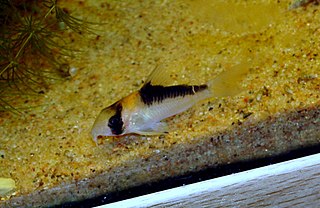
Adolfo's catfish is a tropical freshwater fish belonging to the Corydoradinae sub-family of the family Callichthyidae. It originates in inland waters in South America, and is found in the Rio Negro basin and the Rio Uapes in Brazil. It is also known as Adolfo's corydoras. It has similar patterns to the C. imitator but it has a shorter snout and red coloration in front of its dorsal fin.
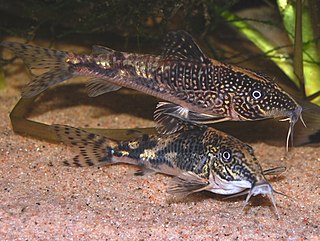
The banded corydoras or bearded catfish is a subtropical freshwater fish belonging to the subfamily Corydoradinae of the family Callichthyidae. It originates in coastal drainages in South America from Rio de Janeiro to Santa Catarina, Brazil.
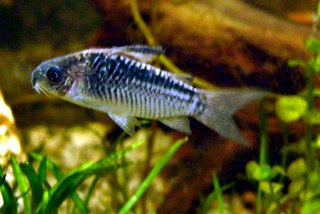
The elegant corydoras or elegant catfish is a tropical freshwater fish belonging to the subfamily Corydoradinae of the family Callichthyidae. It originates in inland waters in South America, and is found in the Upper Amazon River basin in Brazil, Colombia and Peru. The specific epithet elegans means elegant.
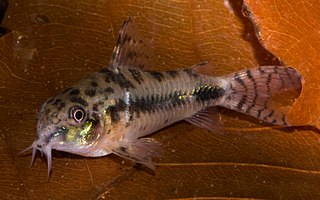
The salt and pepper catfish is a tropical freshwater fish belonging to the Corydoradinae sub-family of the family Callichthyidae. It originates in inland waters in South America, and is found in the Upper Orinoco River basin in Venezuela and Colombia.
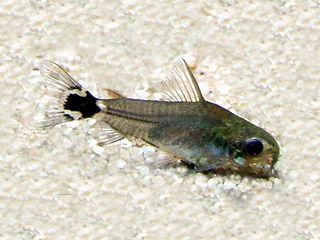
The dwarf corydoras, dwarf catfish, tail spot pygmy catfish, or micro catfish is a tropical freshwater fish belonging to the subfamily Corydoradinae of the family Callichthyidae. It originates in inland waters in South America, and is found in the Amazon River and Paraguay River basins in Argentina, Bolivia, and Brazil. The specific epithet hastatus means with a spear, in reference to the spearhead-like spot on the tail root.
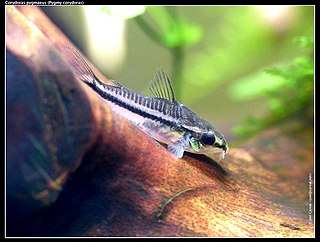
Corydoras pygmaeus, or the pygmy corydoras or pygmy catfish is a tropical and freshwater fish belonging to the subfamily Corydoradinae of the family Callichthyidae. It originates in tropical inland waters in South America, and is found in the Madeira River basin in Brazil.

Corydoras reticulatus, also called the reticulated corydoras, mosaic corydoras, network catfish, or network corydoras, is a tropical freshwater fish belonging to the Corydoradinae sub-family of the family Callichthyidae. It originates in inland waters in South America, and is found in the Lower Amazon River basin in Brazil.
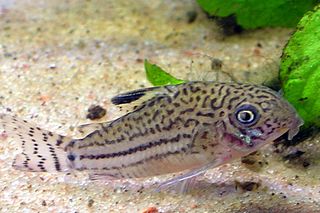
The three stripe corydoras, leopard catfish, false julii corydoras, or three line catfish is a tropical freshwater fish belonging to the subfamily Corydoradinae of the family Callichthyidae. It originates in inland waters in South America, and is found in the central Amazon River basin in Brazil and Colombia, Peruvian [Amazon and coastal rivers in Suriname.
Britski's catfish is a tropical freshwater fish belonging to the subfamily Corydoradinae of the family Callichthyidae native to South America where it is found in the upper Paraguay River basin in Brazil. This species was formerly classified as Brochis britskii.
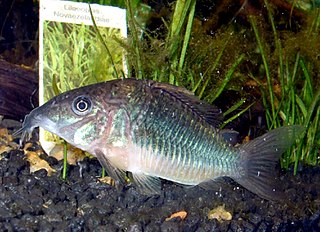
The emerald catfish is a tropical freshwater fish belonging to the Corydoradinae sub-family of the family Callichthyidae native to the Amazon Basin in South America. It has traditionally been known as Brochis splendens. The fish has appeared on a stamp in Brazil.

Callichthys callichthys, the cascarudo, armored catfish, bubblenest catfish, hassar, or mailed catfish, is a subtropical freshwater fish belonging to the subfamily Callichthyinae of the family Callichthyidae.

Corydoras julii is a small freshwater catfish native to eastern Brazil. It is often confused with Corydoras trilineatus, the three stripe corydoras. Corydoras julii are small, peaceful shoaling fish, and are typically kept in groups in captivity.

Corydoras agassizii is a species of catfish found in the Amazon basin. It can be found in the border area of Peru and Brazil. It lives in tropical waters with a water temperature of 22 - 26 °C, a pH of 6.0 - 8.0 and a hardness of 2 - 25 dH.
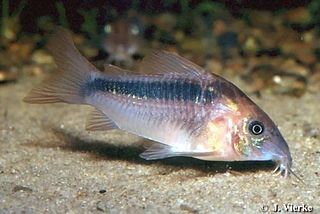
Corydoras rabauti, also known as the rust corydoras, or Rabaut's corydoras is a small species of tropical freshwater armoured catfish native to the Upper Amazon, Solimões, and Rio Negro basins in South America. It was first described by the American ichthyologist Francesca Raimonde La Monte in 1941, and is frequently seen in the aquarium trade.
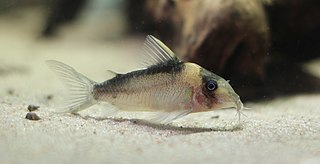
Corydoras imitator is a small species of tropical freshwater armoured catfish native to the Upper Amazon, Solimões, and Rio Negro basins in South America. It was first described by the Dutch icthyologists Han Nijssen and Isaäc J. H. Isbrücker in 1983, and is frequently seen in the aquarium trade.






















